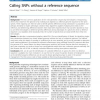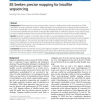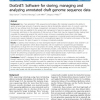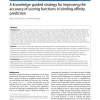9124 search results - page 1787 / 1825 » Requirements-Based Design Evaluation |
115
Voted
BMCBI
2010
15 years 20 days ago
2010
Background: The most common application for the next-generation sequencing technologies is resequencing, where short reads from the genome of an individual are aligned to a refere...
83
Voted
BMCBI
2010
15 years 20 days ago
2010
Background: Bisulfite sequencing using next generation sequencers yields genome-wide measurements of DNA methylation at single nucleotide resolution. Traditional aligners are not ...
114
Voted
BMCBI
2010
15 years 20 days ago
2010
Background: New "next generation" DNA sequencing technologies offer individual researchers the ability to rapidly generate large amounts of genome sequence data at drama...
BMCBI
2010
15 years 20 days ago
2010
Background: Current scoring functions are not very successful in protein-ligand binding affinity prediction albeit their popularity in structure-based drug designs. Here, we propo...
113
Voted
BMCBI
2007
15 years 20 days ago
2007
Background: Microarray techniques survey gene expressions on a global scale. Extensive biomedical studies have been designed to discover subsets of genes that are associated with ...




